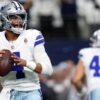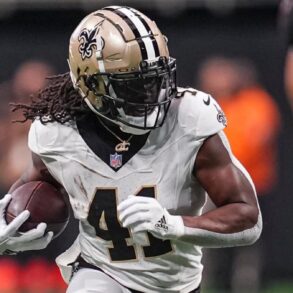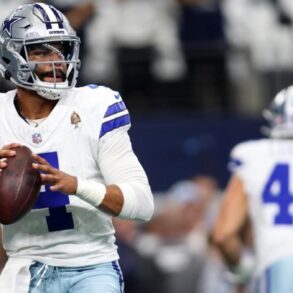Which NFL teams will field the best offenses in 2025?
On the surface, that seems like a straightforward question. But considering how many different ways you can slice up offensive production — total offense, yards per play, DVOA, EPA and additional acronymed statistics my feeble mind cannot comprehend — that initial query needs refinement. And seeing how the basic goal of this game is to score more points than the opposition, that feels like the simplest approach.
Which NFL offenses will score the most points in 2025?
Now we’re talkin’. But before we look forward, it’s useful to look back. Which offenses scored the most point last season? By the metric of OFFENSIVE points per game — in which defensive and/or return scores do not count — these were the top-10 units from the 2024 regular season:
- Detroit Lions: 32.4 ppg
- Buffalo Bills: 29.5
- Baltimore Ravens: 29.3
- Tampa Bay Buccaneers: 28.6
- Washington Commanders: 28.1
- Philadelphia Eagles: 26.7
- Green Bay Packers: 26.6
- Cincinnati Bengals: 26.4
- Minnesota Vikings: 24.2
- Los Angeles Chargers: 23.2
So, which teams will fill each of those slots in the coming campaign? Here’s my prediction in countdown order, from 10 to 1.
As you can imagine, several offenses merited serious consideration for the final slot in this ranking. The JUST MISSED category includes both Los Angeles teams, with the Chargers in Year 2 of Jim Harbaugh’s cultural transformation and the Rams now boasting Davante Adams as their WR2. I also pondered significant steps forward for the Bears’ and Falcons’ attacks, bearing in mind potential sophomore surges from Caleb Williams and Michael Penix Jr. Elsewhere, with Liam Coen and Travis Hunter touching down in Jacksonville, is this the year Trevor Lawrence puts it all together? And with San Francisco fresh off an injury-riddled Super Bowl hangover, is this the year we regrettably overlook Kyle Shanahan’s 49ers?
But after weighing all viable options at No. 10, I took the easy way out: Betting on Andy Reid and Patrick Mahomes.
Despite making the Super Bowl in each of the past two seasons, the Chiefs ranked 12th in offensive points per game in 2024 and 14th in 2023. That’s a notable departure from the first five years of the Reid-Mahomes pairing, when Kansas City ranked first twice and never finished lower than seventh. Everyone knows the main culprit for this downswing: an offensive line that sprung holes, especially on the edge. Consequently, Brett Veach aggressively targeted tackles in free agency (giving Trent Williams understudy Jaylon Moore a two-year, $30 million deal) and the 2025 NFL Draft (spending the first-round pick on Josh Simmons). Is that enough to fully patch up the problem areas? Maybe yes, maybe no — but I trust Reid and Mahomes to put more points on the board this fall, one way or another, especially given cleaner bills of health from running back Isiah Pacheco and wide receivers Rashee Rice and Hollywood Brown.
In 2024, Joe Burrow led all passers in yards (4,918) and touchdowns (43), Ja’Marr Chase won the receiving triple crown and Tee Higgins scored 10 TDs in 12 games to further his case as the league’s top WR2. With both receivers signing nine-figure extensions in March, Cincinnati has enviable star power to fuel the aerial attack for the foreseeable future. Unfortunately, this offense has serious questions when it comes to the meat and potatoes, with Cincy fielding the most suspect line of any team on this list by a comfortable margin. Orlando Brown Jr. leads the group, but the left tackle is coming off an injury-abbreviated campaign. Second-year right tackle Amarius Mims remains a work in progress, which isn’t surprising for a guy who started just eight games in college. On the interior, center Ted Karras is a stalwart, but the Bengals continue to cycle through guards, seeking a combo that sticks. Burrow does his best to mitigate protection issues, processing at supercomputer speed and swiftly getting the ball out, but he still took 48 sacks last season — an alarming figure for a quarterback with a concerning injury history. And while Chase Brown fell just shy of 1,000 yards rushing in an encouraging sophomore campaign, Cincinnati just doesn’t have the kind of backfield beast who can overcome substandard blocking. So, the pressure’s on new offensive line coach Scott Peters, who replaced the fired Frank Pollack in January. A former NFL offensive lineman himself, Peters has spent his opening months on the job stressing technique and hand-striking. That tracks, given that he won two world championships in Brazilian Jiu-Jitsu.
There’s a lot to like about this attack, starting with the man who runs it: Matt LaFleur still somehow feels underrated as a head coach and offensive architect. Meanwhile, the line is deep and diverse. The receiving corps lacks an established WR1, but first-round pick Matthew Golden joins a cavalcade of playmakers with varying sizes and play styles. And Josh Jacobs has proven to be exactly the kind of physical bell-cow back Green Bay desired, rushing for 1,329 yards and 15 touchdowns in his debut season with the Packers. So, with all that in mind …
Will the real Jordan Love please stand up?
Love got off to a slow start after taking the reins from Aaron Rodgers in 2023, but he finished that regular season on an absolute heater (18:1 TD-to-INT ratio in the final eight weeks) before cooking the Cowboys in Dallas on Wild Card Weekend. Two second-half picks in the narrow Divisional Round loss at San Francisco left a bad taste, but Love still entered last season as a trendy MVP dark horse. Unfortunately, he injured his knee in the season opener in Brazil, sidelining him for a couple weeks. Upon return, he never seemed to fully get his groove back, suffering additional health issues and ultimately finishing the campaign with a three-pick meltdown in the wild-card loss at Philadelphia.
What kind of Love will we get in 2025? He has the arm talent and irrational confidence to drop bombs and make this prediction for Green Bay’s offense look conservative. But the sample size is still small enough that we should proceed with caution.
This could be too low for the reigning Super Bowl champs, who feature the best offensive line in football, a 2,000-yard rusher and one of the top receiving duos in the game today. But I’m still not entirely sure what to think of Jalen Hurts. Not that he’s bad, obviously. The guy just won Super Bowl MVP, for god’s sake, and probably deserved that same honor in the Super Bowl that Philadelphia lost three Februarys ago. Hurts is certifiably GOOD — but how good is he? Last season, including the playoffs, he eclipsed 300 yards passing in only one game. And while he provides undeniable value as a runner — particularly with his forward thrust on the “Tush Push” — Hurts doesn’t really take over games with his legs. All in all, the past two seasons just haven’t matched the individual output he produced under Shane Steichen in his MVP runner-up campaign of 2022. In related news, he now has his third new offensive coordinator in as many years, with former passing game coordinator Kevin Patullo promoted to the post after Kellen Moore took the top job in New Orleans. Heading into his fifth season as the full-time starter, the soon-to-be 27-year-old certainly could take a significant step forward. If he does, the offense will follow suit, and I’ll look stupid.
Despite being the 12th overall pick of the 2024 NFL Draft, Bo Nix was the sixth quarterback selected. Naturally, this led many to believe Sean Payton desperately forced the issue at the game’s most important position. And in September, that certainly appeared to be the case:
- Nix’s first four games: 60.1 comp%, 165.0 passing ypg, 4.8 ypa, 1:4 TD-to-INT ratio, 62.5 passer rating.
During that opening month, Denver’s offense averaged a miniscule 14.5 points per game, tied for 29th in the NFL. But after the calendar turned to October, the Broncos turned up, averaging a healthy 25.2 points per game for the remainder of the regular season, ranking ninth in that span. And yes, Nix spearheaded the attack with an astounding about-face:
- Nix’s final 13 games: 68.3 comp%, 239.6 passing ypg, 7.3 ypa, 28:8 TD-to-INT ratio, 103.2 passer rating.
Denver was abruptly blown out of the playoffs by Buffalo, but Nix himself didn’t look out of place. In the coming season, I expect him to pick up where he left off. The Broncos return all five starters from an offensive line that played at an elite level last season. And hey, what do you know: Payton made another early draft pick that had some folks calling REACH! But don’t count me among those questioning second-round selection R.J. Harvey — I’m a big fan of this compact, shifty back with supreme contact balance. With Denver signing J.K. Dobbins this week, Payton’s assembling the kind of multifaceted backfield that served him well in New Orleans.
Detroit easily led the league in offensive scoring last season, averaging nearly three whole points more than the next-best attack (Buffalo). So, what’s with the No. 5 ranking here? Well, the Lions suffered significant attrition, on both the sideline and the field of play. Ben Johnson, who composed a top-five scoring offense in each of his three years as coordinator, finally took a head-coaching job, assuming control of the rival Bears. The offensive line, which has been Detroit’s calling card during this come-up, lost right guard Kevin Zeitler to free agency and center Frank Ragnow to retirement. Suddenly, the unit’s interior is in flux, which is quite worrying for an offense that loves to pound the football. Fortunately, new coordinator John Morton still has plenty of talent at his disposal. Jared Goff just threw a career-best 37 touchdown passes en route to his fourth Pro Bowl nod, furthering one of the league’s best comeback stories. Furthermore, in addition to having one of the best tackle combos in the league today (Penei Sewell and Taylor Decker), the Lions boast a first-team All-Pro receiver (Amon-Ra St. Brown), another 1,000-yard wideout with eye-popping speed (Jameson Williams), a mismatch weapon at tight end (Sam LaPorta) and a bruising back with a nose for the end zone (David Montgomery). But the player who excites me the most on this unit is third-year back Jahmyr Gibbs. A Pro Bowler in each of his first two NFL campaigns, “Sonic” looked like a video game cheat code down the stretch last season, averaging 165.5 scrimmage yards and two touchdowns during his final four games (including playoffs). Honestly, every touch felt like must-see TV. If Detroit can re-settle its interior offensive line, Morton’s biggest challenge will be judiciously feeding all this firepower, a balancing act that Johnson mastered.
C.J. Stroud took the league by storm in Year 1 … before taking a step back in Year 2. Can Jayden Daniels avoid the sophomore slump that befell his Offensive Rookie of the Year predecessor? That’s the question at hand. And given Washington’s placement in the top half of this ranking, I evidently believe he can. Why? Well, Stroud’s regression didn’t occur in a vacuum — the foundation fell apart around him, with his offensive line turning into a sieve while his receiving corps was ravaged by injuries. Obviously, Washington can’t magically guard against the latter — frankly, the team is pressing its health luck with oft-injured receiver Deebo Samuel — but the Commanders did work to fortify their O-line this offseason. Oddly, the big-ticket move was acquiring Stroud’s blind-side protector of the last two years, Laremy Tunsil. The trade sent a shockwave through the league, leading to plenty of speculation as to why the left tackle fell out of favor in Houston. Whatever the case, Tunsil just made his fifth Pro Bowl in the past six seasons, posting Pro Football Focus’ fourth-highest pass-blocking grade among OTs. Still just 30 years old, Tunsil should have plenty left in the tank. And beyond him, Washington’s O-line looks deeper and more talented than the group Houston rolled out last fall. If first-round pick Josh Conerly Jr. proves to be a quick learner, this unit could really take off. What’s more, Daniels seems to be more simpatico with offensive coordinator Kliff Kingsbury than Stroud was with OC Bobby Slowik, whom the Texans fired in January. Lastly, Jayden boasts something that C.J. doesn’t have: electric running ability. When all else fails, that’s the kind of trump card that can help a young quarterback stay on schedule.
Last offseason, I was worried about how Lamar Jackson and Derrick Henry would fit together in the same offense. Talk about an unnecessary concern … Jackson nearly won his third MVP with his best statistical season yet, while Henry averaged a career-high 5.9 yards per carry en route to 1,921 yards and 16 rushing touchdowns. Perhaps I should have known two of the most dynamic players of a generation would make sweet music together. They don’t reach such heights, though, without inspired work from the big boys up front. Forced to replace three starters last season, Baltimore’s offensive line got off to a slow start, but the unit just got better and better as the season progressed. With four of the five starters coming back, the most obvious question is whether Andrew Vorhees is ready to fill the void at left guard following Patrick Mekari’s departure in free agency. But the biggest question might be whether Ronnie Stanley can stay healthy. In a contract season, the left tackle didn’t miss a game for the first time in his nine-year career, making his second Pro Bowl and receiving a three-year, $60 million extension in March. The passing-game weaponry remains robust, with Zay Flowers leading the receivers and Isaiah Likely seemingly poised to overtake Mark Andrews as the team’s top tight end.
Todd Monken has spectacularly reinvigorated the Ravens offense in his first two years on the job, but the coordinator still sees plenty of room for improvement, even with his superstar pupil in the No. 8 jersey.
“I think he’s still just scratching the surface of where he’s headed,” Monken said of Jackson in March.
My colleague Judy Battista listed Baker Mayfield among her dark-horse candidates for MVP. Makes plenty of sense to me. I mean, shoot, look at the supporting cast around the 30-year-old quarterback. It starts up front with one of the premier offensive lines in the game. First-team All-Pro left tackle Tristan Wirfs is the headliner, but this could be the best starting five this side of Philadelphia. The receiver room is loaded with talent, young and old. With veteran wideout Chris Godwin working his way back from a season-ending ankle injury, Jason Licht just spent his first-round pick on Emeka Egbuka, who happens to offer a Godwin-like skill set. Bucky Irving was a revelation last year as the top rookie running back — and frankly, one of the most exhilarating newbies in the entire draft class — while Rachaad White and Sean Tucker provide solid backfield depth. It’s all there for Mayfield, who just tied for second in the NFL in touchdown passes (41) while finishing third in passing yards (4,500) and completion percentage (71.4), to enjoy an even better season in 2025. The potential fly in the ointment: Savvy offensive coordinator Liam Coen left to become the head coach in Jacksonville. On the plus side, the new play-caller isn’t a new face, as Josh Grizzard was internally promoted after serving as Tampa’s pass game coordinator last season. Not to mention, this is nothing new to Baker, who’ll be playing under his fifth OC in as many seasons.
Continuity is the word in Buffalo. After setting a number of franchise records in 2024, the offense is essentially unchanged heading into 2025. The coaches on that side of the ball are the same, highlighted by rising young coordinator Joe Brady and venerable O-line maven Aaron Kromer. Personnel-wise, the Bills return 15 of their top 16 players in offensive snaps from last season. The one loss: Mack Hollins. With all due respect to the receiver’s endearing, blue-collar style, Hollins totaled 482 receiving yards in 20 games with Buffalo (including playoffs), so his departure isn’t exactly crippling. Not when Josh Allen is operating at the peak of his powers, heading into his age-29 season as the NFL’s reigning MVP. And the quarterback is protected by one of the best offensive lines in football, a group that has allowed the fewest sacks in the league in each of the past two seasons. Now, the weaponry beyond Pro Bowl running back James Cook and freshly paid receiver Khalil Shakir still leaves something to be desired, but I anticipate growth from second-year wideout Keon Coleman and third-year tight end Dalton Kincaid. And let’s be honest: The 6-foot-5, 237-pound signal-caller has the ability to operate as a one-man army, making NFL men look like boys in his midst. The 2024 Bills scored at least 30 points in 12 of their 17 regular-season games, hitting the mark eight straight times from mid-October to mid-December. This is a well-oiled machine poised to consistently light up scoreboards once again this fall.
This post was originally published on this site be sure to check out more of their content.








